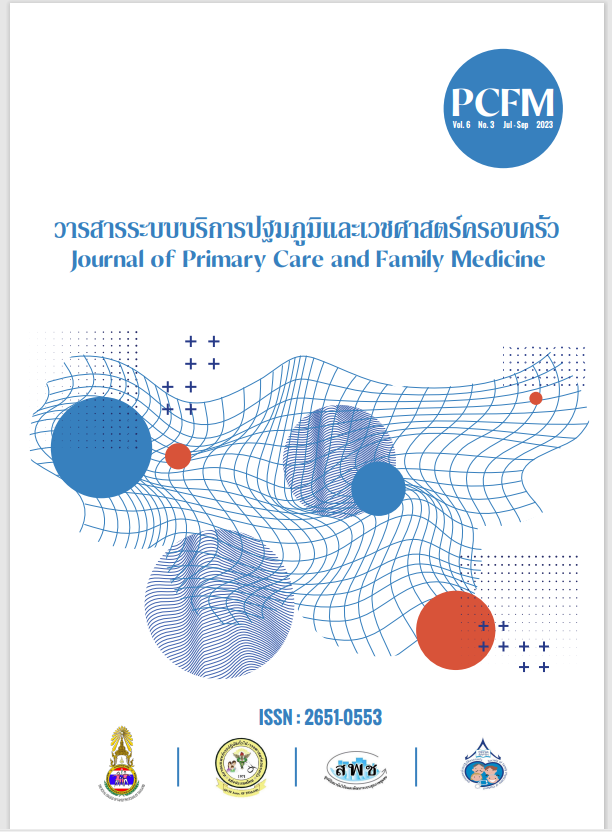Factors Associated with E-Health Literacy in OPD Patients in the Department of Social Medicine at Chonburi Hospital
Main Article Content
Abstract
Background: Nowadays, the internet use plays an important role in the Thai population. It trends to increasing in the future. Thus, e-health literacy is an important thing for managing health problems appropriately.
Objectives: To study the e-health literacy scale and factors associated with e-health literacy in OPD patients.
Methods: A cross-sectional descriptive study was conducted using a questionnaire among OPD patients, in a total of 450 samples. The study was conducted from September to November 2021 in the Department of Social Medicine at Chonburi Hospital. The questionnaire contains demographic data of patients, internet usage behavior adapted from Health Information National Trends Survey Cycle 3 (qualitative measure), e-health literacy questionnaire from Public Health Department translated from the e-health literacy scale created by CD Norman, HA Skinner (Cronbach’s alpha coefficient = 0.9). Factors associated with e-health literacy in OPD patients analyzed by multiple regression.
Results: The results revealed that most participants (61.1%) had a high e-health literacy scale (26-40). The factors associated with e-health literacy in OPD patients (p < 0.05) were age (p < 0.05), education level (p < 0.01), occupation (p < 0.01), and number of electronic devices (p < 0.01).
Conclusions: From this study, the e-Health Literacy Scale depended on multiple factors; therefore, Knowledge about predicting factors is an important thing for promoting e-health literacy in the future. For example, Media creation can be appropriately adjusted by e-health literacy levels.
Article Details

This work is licensed under a Creative Commons Attribution-NonCommercial-NoDerivatives 4.0 International License.
The content and information in articles published in the PCFM journal are solely the opinions and responsibilities of the authors. The journal's editorial board does not necessarily agree with or share any responsibility for them.
All articles, information, content, images, etc., published in the PCFM journal are the copyright of the PCFM journal. If any individual or organization wishes to reproduce, distribute, or use any part or the entirety of the content, they must obtain written permission from the PCFM journal beforehand.
References
ณรงค์ยศ มหิตติวานิชย์. สถิติและพฤติกรรมผู้ใช้งาน internet Q1 ปี 2563 ทั่วโลกรวมประเทศไทย [อินเทอร์เน็ต].2563 [เข้าถึงเมื่อ 19 มีนาคม 2564]. เข้าถึงได้จาก: https://www.twfdigital.com/blog/2020/02/global-digital-usage-stat-q1-2020/
สำนักงานสถิติแห่งชาติ กระทรวงดิจิทัลเพื่อเศรษฐกิจและสังคม. การสำรวจการมีการใช้เทคโนโลยีสารสนเทศและการสื่อสารในครัวเรือน [อินเทอร์เน็ต]. 2561 [เข้าถึงเมื่อ 19 มีนาคม 2564]. เข้าถึงได้จาก: www.nso.go.th/sites/2014/ DocLib13/ด้านICT/เทคโนโลยีในครัวเรือน/2561/ict61-CompleteReport-Q1.pdf
พนิตนาฏ ชำนาญเสือ, จันทิมา เขียวแก้ว, พรเลิศ ชุมชัย, ธัญญารัศม์ ดวงคำ, ฉัตรทอง จารุพิสิฐไพบูลย์, กฤษณา หงส์ทอง และคณะ. การรู้สารสนเทศด้านสุขภาพ การรู้สารสนเทศอิเล็กทรอนิกส์ด้านสุขภาพ และสภาวะสุขภาพของนักศึกษาวิทยาลัยพยาบาลสังกัดพระบรมราชชนก ในกลุ่มเครือข่ายภาคกลาง 2และภาคตะวันออกเฉียงเหนือ. วารสารวิจัยสมาคมห้องสมุด .2559; 9 : 93-117.
จุไรรัตน์ ดวงจันทร์, จันทิมา แก้วเขียว, พนิตนาฎ ชำนาญเสือ, เยาวลักษณ์ มีบุญมาก, จุฬารัตน์ ห้าวหาญ, พรเลิศ ชุมชัย และคณะ. ปัจจัยทำนายการรู้สารสนเทศอิเล็กทรอนิกส์ด้านสุขภาพของนักศึกษาพยาบาล วิทยาลัยพยาบาลสังกัดพระบรมราชชนก. วารสารวิชาการมหาวิทยาลัยอีสเทิร์นเอเชีย.2560; 11:235-248.
วรรณรัตน์ รัตนวรางค์. พฤติกรรมการใช้อินเทอร์เน็ตเพื่อหาข้อมูลสุขภาพของผู้สูงอายุในเขตกรุงเทพมหานคร. วารสารพฤติกรรมศาสตร์เพื่อการพัฒนา.2558; 7:169-185.
Tanvir AM. The Use of Technology to Access Healthcare: An Exploration of eHealth Literacy and Related Disparity in Bangladesh [PhD]. Brighton: University of Sussex; 2019.
Bethany T, Michael S, Virginia D, Beth C, Don C, Samantha P, et al. eHealth Literacy and Web 2.0 Health Information Seeking Behaviors Among Baby Boomer and Older Adults. J Med Internet Res 2015;17;1-16
ภานุพงศ์ พรหมมาลี. การวิเคราะห์การรู้ดิจิทัลของอาจารย์ระดับอุดมศึกษาโดยใช้แผนภูมิต้นไม้การจำแนกและการถดถอย [วิทยานิพนธ์ปริญญาเภสัชศาสตร์มหาบัณฑิต]. นครปฐม: มหาวิทยาลัยศิลปากร ; 2562
Diane LZ, Isabella B. Media Health Literacy, eHealth Literacy, and the Role of the Social Environment in Context. Int. J. Environ. Res. Public Health 2018, 15, 1-13
ภัทรานิษฐ์ เหมาะทอง, วนิดาทองโคตร, สุพรรณี อึ้งปัญสัตวงศ์. การกำหนดขนาดตัวอย่างโดยใช้สูตร Yamane [อินเทอร์เน็ต].2560 [เข้าถึงเมื่อ 19 มีนาคม 2564]. เข้าถึงได้จาก: http://sc2.kku.ac.th/stat/statweb/images/
Eventpic/60/Seminar/01_9_Yamane.pdf
Rockville. Health information National Trends Survey cycle 3. [Internet].2020 [cites 2021 Feb 1].
Available form: https://hints.cancer.gov/docs/Instruments/HINTS5C3_Annotated_Instrument_English.pdf
สำนักงานโครงการขับเคลื่อนกรมอนามัย 4.0. Health Literacy and Health Literate Organization [อินเทอร์เน็ต]. กรมอนามัย กระทรวงสาธารณสุข. 2563 [เข้าถึงเมื่อ 1 กุมภาพันธ์ 2564]. เข้าถึงได้จาก:https://apps.hpc.go.th/dl/web/upFile/2019/02-5044-20190218125342/36c4407dadeb64d841a1c0dfa3997179.pdf
Richtering SS, Hyun K, Neubeck L, Coorey G, Chalmers J, Usherwood T, et al. Predictors in a Population with Moderate-to-High Cardiovascular Risk. JMIR Hum Factors 2017 [cite 2022 Feb 8];4(1):e4. doi:10.2196/humanfactors.6217.
Shiferaw KB, Mehari EA. Internet use and eHealth literacy among health-care professionals in a resource limited setting: a cross-sectional survey. Adv Med Educ Pract.2019;10:563-570.
Norman CD, Skinner HA. eHealth Literacy: Essential Skills for Consumer Health in a Networked World. J Med Internet Res 2006;8(2):e9.
ธนิตา วงษ์จินดา. ผลการพัฒนาระบบสนับสนุนบนฐานเว็บเพื่อการสร้างเสริมสุขภาพทหารโดยใช้แนวทางการมีส่วนร่วม กรมทหารราบที่ 1 มหาดเล็กรักษาพระองค์ฯ[วิทยานิพนธ์ปริญญาดุษฎีบัณฑิต]. กรุงเทพฯ: มหาวิทยาลัยจุฬาลงกรณ์. 2559.
ปรียาภรณ์ บูรณากาญจน์, ศศิธร ยุวโกศล. ปัจจัยที่มีอิทธิพลต่อการรู้เท่าทันสื่อสุขภาพด้านพฤติกรรมการเลี้ยงลูกด้วยนมแม่ของมารดาตั้งครรภ์. วารสารวิชาการนวัตกรรมสื่อสารสังคม 2563; 8(2): 136-149.
Shiferaw KB, Tilahun BC, Endehabtu BF, Gullslett MK,Mengiste SA. E-health literacy and associated factors among chronic patients in a low-income country: a cross-sectional survey. BMC Med Inform Decis Mak 2020;20(1):181.
Centers for disease control and prevention. e-Health Literacy. [Internet].2021 [cites 2021 March 30]. Available form: https://www.cdc.gov/healthliteracy/researchevaluate/eHealth.html
เนติยา แจ่มพิม, สินีพร ยืนยง. การใช้สื่อออนไลน์และการรู้เท่าทันสื่อสารสนเทศสุขภาพออนไลน์ของผู้สูงอายุ จังหวัดสุพรรณบุรี. วารสารวิทยาลัยพยาบาลบรมราชชนนี นครราชสีมา 2562;25(2);168-180.
พรพรรณ ประจักษ์เนตร. ความสัมพันธ์ระหว่างการรู้เท่าทันสื่อสุขภาพแบบออนไลน์ การค้นหาข้อมูลข่าวสาร ความรู้ ทัศนคติและการจัดการตนเองเพื่อรักษาโรคติดเชื้อเฉียบพลันในระบบทางหายใจส่วนบนของประชากรไทย. วารสารวิจัยระบบสาธารณสุข 2562;13(3);243-260.
Xesfingi S, Vozikis A. eHealth Literacy: In the Quest of the Contributing Factors. Interact J Med Res 2016;5(2):e16.
Sisook Kim RN, Jaehee Jeon RN. Factors influencing eHealth literacy among Korean nursing students: A cross-sectional study. Nursing and Health Science 2020;22(3):667-674.
Zhou J, Fan T. Understanding the Factors Influencing Patient E-Health Literacy in Online Health Communities (OHCs): A Social Cognitive Theory Perspective. Int. J. Environ. Res. Public Health 2019;16(14),2455.
Zrubka Z, Brito Fernandes Ó, Baji P, Hajdu O, Kovacs L, Kringos D, et all. Exploring e-Health Literacy and Patient-Reported Experiences With Outpatient Care in the Hungarian General Adult Population: Cross-Sectional Study. J Med Internet Res 2020;22(8):e19013


